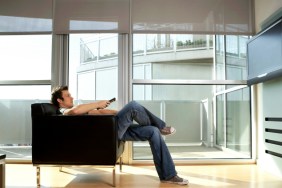Technology is amazing, isn’t it? It seems not all that long ago that the best TVs were flat, and then, out of nowhere comes something like the new Samsung SUHD Curved Screen TV and suddenly the whole world has gone topsy-turvy.
Emerging from the ‘concept corners’ of technology shows, curved TVs have suddenly exploded onto the mainstream scene with Samsung reporting that its flagship curved SUHD TVs are outselling its flagship flat UHD TVs by 3:1.
And while with sales figures like that, it looks like they’re here to stay. But we all know that popularity doesn’t equal quality so still, the question remains; Should you buy one?
Also See: Is It Worth Buying a 4K TV Now? Pros and Cons of Moving to Ultra HD
Here to help you out is our list of the 5 Pros And Cons Of Buying A Curved Screen TV… brought to you by the new Samsung SUHD Curved Screen TV.
Pro: They’re More Immersive
This is really the main selling point of curved screen TVs, that curving them towards you fills out your peripheral and makes you feel like you’re “in the picture”. I mean, it’s not like you look at life as a flat screen, there is a world to either side of you and that’s what these new sets exploit.

Yeh, this immersive. (Photo: Supplied)
Con: They’re More Immersive
If you’re a bit of a chicken maybe don’t go ahead and watch a horror movie late at night with these new bad boys. Or at least, don’t be drinking a hot soup whilst doing so. We’re not kidding about how real the TV experience is getting and we’d hate for you to ruin that new shirt…
Pro: They Feel Wider
Don’t ask me to explain the maths/magic behind this one, but just as curving the screen towards you feels more immersive, it also plays a trick and your brain and makes you perceive the image as wider. I have no proof, but I think they might be contouring the screen a la Kim Kardashian.
Con: They Take Up More Room
Being curved they do therefore take up more room than a flat screen, because science. Not only that, though, but to get a lot of the advantages of the curved screen you need to go big in terms of size. Some reviews are calling the 55-inch models underwhelming, so if you do buy one make sure it’s 65 inches or bigger. I mean you’re buying a curved screen TV, why not buy a huge one.
Pro: Pictures Feel Like They Have More Depth
This is the freakiest effect many people notice first, with some saying curved screen images even look 3D. Well that’s cos they are ya dingus, being curved meaning of course that the images exist on multiple planes of depth with a physical foreground and background. You know like the world around us. Samsung, in particular, has nailed this aspect using special processing on the SUHD better exploit the way the curve accentuates depth.
Con: You Have To Be Sitting In Just The Right Spot To Get The Right Effect
If immersive and enhanced perception of width and depth are the main selling points of curved screen TVs, the fact they only really work when you’re sitting in just the right spot. Multiple people can still watch a film together, but to get the full effect would be less than comfortable. Still, as with most problems associated with curved screens, the bigger you go the smaller the problem.

Just watch TV like this, you’ll be fine. (Image: NBC)
Tracking the natural shape of your eyes better than their flat counterparts curved screens look sharper at their edges, especially in the bigger models since the bigger the screen the more likely your eyes are to perceive a reduction in clarity at the edges if that screen is flat. This is no surprise as many commercial cinemas, of course, use curved screens for this very reason and is yet another subtle hint Samsung is giving you to buy a huge one.
Con: The Curve Exaggerates Reflections
This one is a bit of a bummer, as the curve, of course, exaggerates reflections the way a fun house mirror does. What that means is that whereas on a normal screen you’d only see the light itself reflected, not you get radial bands of light that are very distracting. This, of course, leans into the fact that this is essentially a home cinema machine and not an everyday viewing device. Unless, of course, you want to watch TV in the dark all the time.
Pro: You Get Better Contrast Performance
Not this one is the most science-y of all the prop points, the theory being that since curved screens focus their light towards your seating position rather than scattering it like those wasteful flat TVs do, curved screens can deliver almost twice as much perceived contrast. I’m not quite sure how this is measured, or if it even exists outside of a promotional brochure, but the idea that the TV is beaming the images at you like a televisual Deathstar was just too cool not to include in this list.
Con: Tiny People May Break Into Your House And Try And Use Your TV As A Half Pipe
Ok, so this one isn’t likely to happen, but we here at Crave Online like to be prepared for all scenarios, and so should you. You never know what to expect, but this is a small price to pay for such amazing picture quality if yo ask me.







